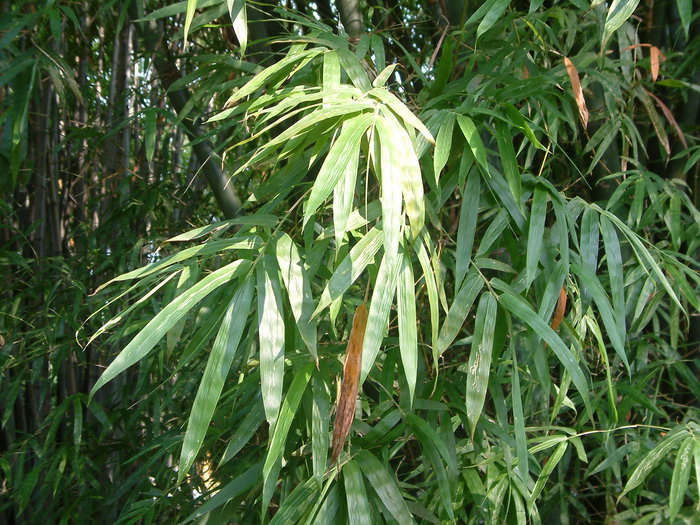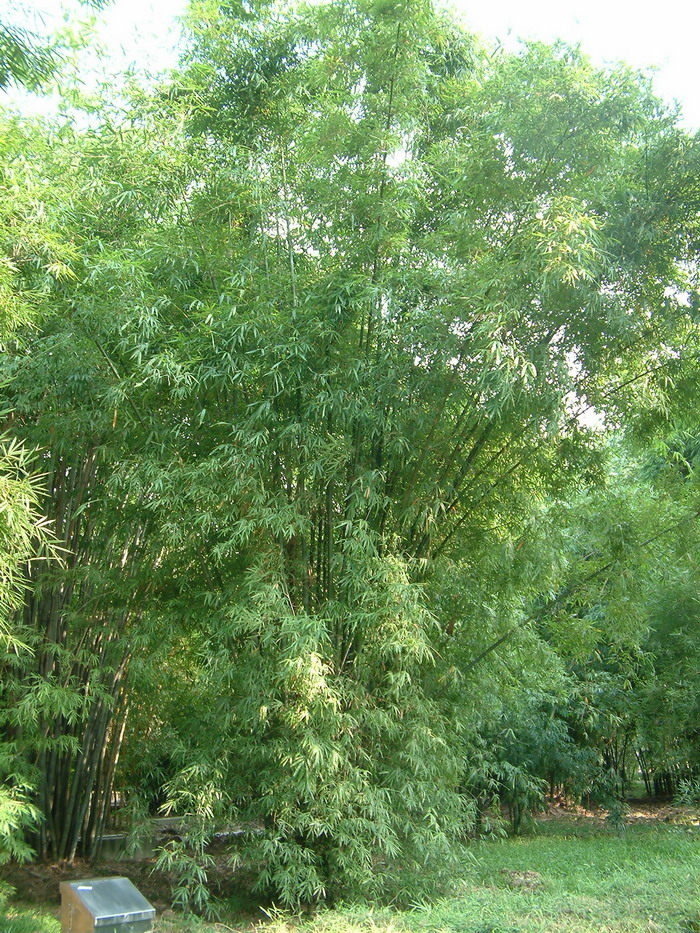长枝竹Bambusa dolichoclada
中文名(Chinese Name):长枝竹
学名(Scientific Name):Bambusa dolichoclada Hayata
英文名(English Common Name):
别名(Chinese Common Name):
异名(Synonym):Leleba dolichoclada (Hayata) Odash.
科属(Family & Genus):禾本科(Gramineae)簕竹属Bambusa
形态特征(Description):竿高10-15米,直径4.5-8厘米,尾梢略弯,下部近挺直;节间长30-45厘米,幼时厚被白蜡粉,无毛,竿壁稍厚;节处不隆起,竿下部数节于箨环之上方环生一圈灰白色绢毛;分枝性习低,常自竿基部第一节开始,以3枝乃至多枝簇生,主枝较粗长。箨鞘早落,革质,背面薄被白蜡粉,并沿顶端及两侧的上半部密生棕色短硬毛,先端稍向外侧的一边倾斜而呈稍不对称的宽拱形,或有时近于斜截形,内侧的边缘上部则被短纤毛;箨耳稍皱缩,其末端近钝圆,边缘及内面均被密生的波曲状繸毛,两耳显著不相等,大耳卵状长圆形或狭卵形,横长2-2.5厘米,高0.8-1厘米,小耳卵形或椭圆形,其大小约为大耳的1/3;箨舌高3-4毫米,边缘微齿裂,并被长达5毫米的流苏状毛;箨片直立,易脱落,呈不对称的卵状三角形,背面疏生暗棕色小刺毛,腹面在脉间密生淡棕色小刺毛,先端渐尖具硬尖头,基部略作圆形,收窄后即与两侧箨耳相连,此相连部分为3-5毫米,箨片基部宽度约为箨鞘先端宽的2/3,仅在边缘下部被纤毛。叶鞘纵肋明显,被粗硬毛,背部具脊;叶耳小,斜卵形,边缘具长达8毫米的繸毛;叶舌近截形,极低矮,背面被微糙毛;叶片线形至线状披针形,长10-26厘米,宽1-2.3厘米,上表面无毛而显光泽,下表面被短柔毛,先端渐尖具粗糙钻状尖头,基部近钝圆或楔形。假小穗以3-9枚簇生于花枝各节;小穗线形,长3-4厘米,宽6-8毫米,含小花4-12朵,基部托以数片具芽苞片;颖2片,卵形或宽卵形,长2-4.5毫米,具14脉,先端急尖;外稃卵形,长约9毫米,具18-20脉,脉间还有小横脉,先端急尖;内稃长约8.5毫米,具2脊,脊上密生短纤毛;花药黄色,长4.5毫米,顶端微凹缺;子房倒卵形,长2毫米,顶部疏生短硬毛,花柱极短,柱头3,羽毛状。
分布(Distribution):产福建、台湾。常生于海拔300米以下的林边或村落附近。
用途(Use):竿供建筑和制造家具之用;劈篾用以编制农用竹器,如竹篓、米筛、粪箕、斗笠以及捕鱼笼等。
引自中国植物志英文版FOC Vol. 22 Page 19, 25
Bambusa dolichoclada Hayata, Icon. Pl. Formosan. 6: 144. 1916.
长枝竹 chang zhi zhu | Poaceae | Bambusa
Leleba dolichoclada (Hayata) Odashima.
Culms 10–15 m, 4.5–8 cm in diam., basally erect, apically slightly drooping; internodes 30–45 cm, initially thinly white powdery; wall slightly thick; nodes flat, lower several with rings of gray-white silky hairs; branching from basal node up. Branches 3 to many per node, central 3 dominant. Culm sheaths deciduous, leathery, thinly white powdery, densely shortly stiffly brown hairy around apex and upper parts of both sides, apex slightly slanted along one side and slightly asymmetrical, broadly arched, sometimes subtruncate; auricles usually slightly wrinkled with obtuse ends, obviously unequal; larger auricle oblong or narrowly ovate, 2–2.5 × 0.8–1 cm, smaller auricle ovate or elliptic, to 1/3 size of larger one; oral setae undulate, densely covering margins and adaxial surface; ligule 3–4 mm, slightly dentate, fringed with hairs ca. 5 mm; blade deciduous, erect, asymmetrically ovate-triangular, base slightly narrowed and then joined with auricles for 3–5 mm, nearly 2/3 width of sheath apex, abaxially sparsely stiffly dull brown hairy, adaxially densely stiffly pale brown hairy between veins, apex acuminate, apiculate. Leaf blade linear to linear-lanceolate, 10–26 × 1–2.3 cm, abaxially pubescent, adaxially glabrous and glossy. Pseudospikelets in clusters of 3–9 at nodes of flowering branches. Spikelets linear, 3–4 × 0.6–0.8 cm; florets 4–12 preceded by several gemmiferous bracts. Glumes 2, ovate or oval, 2–4.5 mm, 14-veined, apex acute; lemma ovate, ca. 9 mm, 18–20-veined, apex acute; palea ca. 8.5 mm, keels densely ciliolate. Anthers yellow, ca. 4.5 mm, apex emarginate. Ovary obovoid, ca. 2 mm, apex sparsely hispidulous; style very short; stigmas 3.
* Forest margins, around villages; below 300 m. Fujian, Taiwan.
A cultivar, Bambusa dolichoclada 'Stripe' (条纹长枝竹 tiao wen chang zhi zhu) is cultivated in S Taiwan. This differs from the typical plant by its yellow-green culms and branches, later becoming pale yellow with deep green stripes, and its pale green culm sheaths, initially with several fine milky-yellow stripes


(责任编辑:徐晔春)
学名(Scientific Name):Bambusa dolichoclada Hayata
英文名(English Common Name):
别名(Chinese Common Name):
异名(Synonym):Leleba dolichoclada (Hayata) Odash.
科属(Family & Genus):禾本科(Gramineae)簕竹属Bambusa
形态特征(Description):竿高10-15米,直径4.5-8厘米,尾梢略弯,下部近挺直;节间长30-45厘米,幼时厚被白蜡粉,无毛,竿壁稍厚;节处不隆起,竿下部数节于箨环之上方环生一圈灰白色绢毛;分枝性习低,常自竿基部第一节开始,以3枝乃至多枝簇生,主枝较粗长。箨鞘早落,革质,背面薄被白蜡粉,并沿顶端及两侧的上半部密生棕色短硬毛,先端稍向外侧的一边倾斜而呈稍不对称的宽拱形,或有时近于斜截形,内侧的边缘上部则被短纤毛;箨耳稍皱缩,其末端近钝圆,边缘及内面均被密生的波曲状繸毛,两耳显著不相等,大耳卵状长圆形或狭卵形,横长2-2.5厘米,高0.8-1厘米,小耳卵形或椭圆形,其大小约为大耳的1/3;箨舌高3-4毫米,边缘微齿裂,并被长达5毫米的流苏状毛;箨片直立,易脱落,呈不对称的卵状三角形,背面疏生暗棕色小刺毛,腹面在脉间密生淡棕色小刺毛,先端渐尖具硬尖头,基部略作圆形,收窄后即与两侧箨耳相连,此相连部分为3-5毫米,箨片基部宽度约为箨鞘先端宽的2/3,仅在边缘下部被纤毛。叶鞘纵肋明显,被粗硬毛,背部具脊;叶耳小,斜卵形,边缘具长达8毫米的繸毛;叶舌近截形,极低矮,背面被微糙毛;叶片线形至线状披针形,长10-26厘米,宽1-2.3厘米,上表面无毛而显光泽,下表面被短柔毛,先端渐尖具粗糙钻状尖头,基部近钝圆或楔形。假小穗以3-9枚簇生于花枝各节;小穗线形,长3-4厘米,宽6-8毫米,含小花4-12朵,基部托以数片具芽苞片;颖2片,卵形或宽卵形,长2-4.5毫米,具14脉,先端急尖;外稃卵形,长约9毫米,具18-20脉,脉间还有小横脉,先端急尖;内稃长约8.5毫米,具2脊,脊上密生短纤毛;花药黄色,长4.5毫米,顶端微凹缺;子房倒卵形,长2毫米,顶部疏生短硬毛,花柱极短,柱头3,羽毛状。
分布(Distribution):产福建、台湾。常生于海拔300米以下的林边或村落附近。
用途(Use):竿供建筑和制造家具之用;劈篾用以编制农用竹器,如竹篓、米筛、粪箕、斗笠以及捕鱼笼等。
引自中国植物志英文版FOC Vol. 22 Page 19, 25
Bambusa dolichoclada Hayata, Icon. Pl. Formosan. 6: 144. 1916.
长枝竹 chang zhi zhu | Poaceae | Bambusa
Leleba dolichoclada (Hayata) Odashima.
Culms 10–15 m, 4.5–8 cm in diam., basally erect, apically slightly drooping; internodes 30–45 cm, initially thinly white powdery; wall slightly thick; nodes flat, lower several with rings of gray-white silky hairs; branching from basal node up. Branches 3 to many per node, central 3 dominant. Culm sheaths deciduous, leathery, thinly white powdery, densely shortly stiffly brown hairy around apex and upper parts of both sides, apex slightly slanted along one side and slightly asymmetrical, broadly arched, sometimes subtruncate; auricles usually slightly wrinkled with obtuse ends, obviously unequal; larger auricle oblong or narrowly ovate, 2–2.5 × 0.8–1 cm, smaller auricle ovate or elliptic, to 1/3 size of larger one; oral setae undulate, densely covering margins and adaxial surface; ligule 3–4 mm, slightly dentate, fringed with hairs ca. 5 mm; blade deciduous, erect, asymmetrically ovate-triangular, base slightly narrowed and then joined with auricles for 3–5 mm, nearly 2/3 width of sheath apex, abaxially sparsely stiffly dull brown hairy, adaxially densely stiffly pale brown hairy between veins, apex acuminate, apiculate. Leaf blade linear to linear-lanceolate, 10–26 × 1–2.3 cm, abaxially pubescent, adaxially glabrous and glossy. Pseudospikelets in clusters of 3–9 at nodes of flowering branches. Spikelets linear, 3–4 × 0.6–0.8 cm; florets 4–12 preceded by several gemmiferous bracts. Glumes 2, ovate or oval, 2–4.5 mm, 14-veined, apex acute; lemma ovate, ca. 9 mm, 18–20-veined, apex acute; palea ca. 8.5 mm, keels densely ciliolate. Anthers yellow, ca. 4.5 mm, apex emarginate. Ovary obovoid, ca. 2 mm, apex sparsely hispidulous; style very short; stigmas 3.
* Forest margins, around villages; below 300 m. Fujian, Taiwan.
A cultivar, Bambusa dolichoclada 'Stripe' (条纹长枝竹 tiao wen chang zhi zhu) is cultivated in S Taiwan. This differs from the typical plant by its yellow-green culms and branches, later becoming pale yellow with deep green stripes, and its pale green culm sheaths, initially with several fine milky-yellow stripes
(责任编辑:徐晔春)
踩一下[1]

顶一下[0]